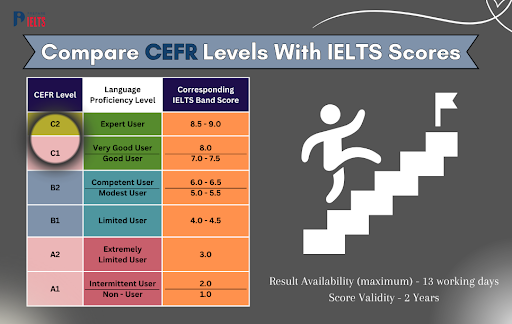
Overview
Did you know that, besides IELTS, PTE, and TOEFL, another method to evaluate one’s English language proficiency is available for all students and trainers?
CEFR, commonly known as the Common European Framework of References for Languages IELTS, is an evaluation scale on which a student’s or a person's proficiency is tested in the European region. This particular evaluation has various levels that will be discussed further in the blog.
The blog aims to explain how to evaluate your IELTS score from the CEFR levels and how well you can categorise yourself, along with a comparison. So, without any further delay, let’s begin!
What is CEFR Level?
The Common European Framework of Reference for Languages (CEFR) is a comprehensive scale comprising six proficiency levels, denoted as A1, A2, B1, B2, C1, and C2. Ranging from essential fluency (A1) to native-fluency level (C2), it replaces the traditional descriptors of language ability, such as "beginner," "intermediate," and "advanced."
Widely adopted in Europe, this scale serves as a more reliable indicator for interpreting and comparing language proficiency levels among teachers and learners. Initially introduced by the Council of Europe in the 1990s, the CEFR English test has become a widely recognised language standard.
CEFR Level IELTS facilitates language teaching and testing by providing a structured framework for analysing English language proficiency. In addition to its utility or significance within Europe, companies and educational institutions use CEFR to compare language qualifications with other exams in their respective countries.
CEFR's versatility extends beyond IELTS, as it also converts scores from tests like TOEFL and PTE. Cambridge Assessment English (CAE) has played a pivotal role in establishing the correlation between IELTS band scores and CEFR fluency levels, recognising the unique characteristics of CEFR level IELTS.

According to the Council of Europe, the CEFR test serves several key objectives:
-
Promoting plurilingualism: Encouraging diversity and multilingualism in curricula.
-
Developing language curricula: Creating positive 'can-do' statements and descriptors based on learners' interests, needs, and age groups.
-
Designing teaching materials: Developing notes, textbooks, and other teaching materials to enhance language learning.
-
Ensuring quality in learning and assessment: Providing benchmarks for quality and success in the learning process, teaching, and standardised assessment.
-
Supporting plurilingual profiles: Assisting in developing plurilingual profiles for language learners.
-
Ensuring transparency and comparability: Maintaining transparency and comparability of certifications.
-
Facilitating teacher education and cooperation: Enabling teacher education and fostering cooperation among teachers and educators of various languages.
Here is a chart that indicates CEFR levels and language proficiency levels:
| CEFR Level | Language Proficiency Level |
|---|---|
|
C2 |
Expert User |
|
C1 |
Very Good User |
|
Good User |
|
|
B2 |
Competent User |
|
Modest User |
|
|
B1 |
Limited User |
|
A2 |
Extremely Limited User |
|
A1 |
Intermittent User |
|
Non - User |
How to compare CEFR level IELTS scores?
First, let us get to know how to compare CEFR Level IELTS scores in the table below:
| CEFR Level | Language Proficiency Level | Corresponding IELTS Band Score |
|---|---|---|
|
C2 |
Expert User |
8.5 - 9.0 |
|
C1 |
Very Good User |
8.0 |
|
Good User |
7.0 - 7.5 |
|
|
B2 |
Competent User |
6.0 - 6.5 |
|
Modest User |
5.0 - 5.5 |
|
|
B1 |
Limited User |
4.0 - 4.5 |
|
A2 |
Extremely Limited User |
3.0 |
|
A1 |
Intermittent User |
2.0 |
|
Non - User |
1.0 |
|
|
Result Availability (maximum) |
13 working days |
|
|
Score Validity |
2 Years |
|
CEFR Level A1
Describing a basic user, Level A1 involves understanding and using simple terms, providing personal information, and engaging in conversations about common everyday topics.
CEFR Level A2
For a basic user at Level A2, individuals can interpret commonly used phrases in various contexts, such as shopping or work, give simple directions, and discuss personal preferences and requirements.
CEFR Level B1
At CEFR Level B1, characterised as an independent user, individuals can understand and discuss topics like family, friends, work, and leisure activities. At this level, individuals can express their travel needs and write brief paragraphs about their interests, aspirations, and experiences.
CEFR Level B2
CEFR level B2 represents an independent user who can compose documents on various themes, comprehend complex texts, and engage in natural conversations with native speakers.
CEFR Level C1
A proficient user at Level C1 can understand complex talks or messages, explain intricate concepts in professional, social, or formal situations, and write detailed texts on in-depth subjects.
CEFR Level C2
Designated for proficient users, Level C2 involves comprehending and summarising easily understandable information and expressing oneself clearly, even in challenging circumstances.
Similarly, the International English Language Test System (IELTS) is a standardised test with four sections: Listening, Reading, Writing, and Speaking. Non-native English speakers take this test to show their language proficiency. Scores, ranging from 0 to 40, are converted to the band scale of 0 to 9.
Register Now, for a free Mock test - Join Today!
Why Compare CEFR with IELTS?
Now that you understand the comparison chart of CEFR Level IELTS let’s examine why it is necessary to compare CEFR with IELTS. Comparing CEFR with IELTS is essential if you're considering studying at European universities.
Understanding the relationships and comparative scenarios between CEFR Level IELTS scores is crucial. Here's why:
-
Standardised scales in CEFR: The CEFR level utilises more standardised scales to assess fluency in the English language.
-
Comparison in Europe: In Europe, teachers, examiners, and students use CEFR to compare language skills and scores from various tests and qualifications such as the IELTS, PTE, TOEFL and many more.
-
Difficulty in measuring IELTS bands: Schools, colleges, and universities often need help to measure a student's language proficiency based on specific IELTS bands (e.g., 8.0 - 8.5).
-
Interpreting IELTS scores to CEFR levels: Institutions interpret IELTS scores to CEFR levels to better understand a candidate's language proficiency.
-
Correlation between IELTS bands and CEFR levels: An IELTS band score of 7.5 equates to the C1 level, while a score of 4.5 corresponds to the CEFR level B1. This correlation helps IELTS users understand how their scores align with CEFR levels.
-
Elimination of vague terms: Comparing CEFR level IELTS scores eliminates vague terms like "Basic," "Intermediate," and "Advanced," thereby providing more accurate indicators of language proficiency.
-
Conversion Process by CEFR: CEFR, standing for reflection, communication, and empowerment, converts IELTS scores recorded in the Test Report Form into the corresponding CEFR levels through a simple process that helps students get into European universities more effectively, as CEFR scores are more prominent and widely accepted in Europe.
Importance of Language Proficiency Tests
Language proficiency tests examine individuals' skills or abilities concerning a particular language proficiency, which is necessary for living and studying abroad. A candidate can determine their current level of proficiency in learning a new language by receiving a reliable and accurate indication of their foreign language proficiency. Moreover, the significance of language proficiency tests is explained below in detail:
-
Academic Chances:
1. University Admission
Proof of language competency is often required to enter colleges and educational institutions. A good result on the language proficiency exam can make getting into prominent programs easier.
2. Scholarships and Grants
Financial assistance and scholarships are only available to students with specific language competency requirements.
-
Immigration and Visa Requirements
1. Visa Applications
In many countries, proof of language ability is required when applying for a visa, particularly work or study visas.
2. Permanent Residency
Communicating in another language is frequently a prerequisite for obtaining citizenship or permanent residency in another nation.
-
Professional Advantages
1. Employment Advantages
Employers frequently require language competency for positions requiring non-native language communication. A proficiency test result may benefit your resume.
2. Career Advancement
Proving one's language proficiency can lead to prospects for job advancement, overseas postings, and promotions.
-
Global Mobility
1. Study Abroad
Gaining admission to foreign universities is made simpler by the need for students to demonstrate their language skills to study abroad.
2. Travel
Interacting successfully in other nations when travelling might make your travels more enjoyable.
Conclusion
To summarise, understanding "CEFR level IELTS" is crucial for studying in Europe. CEFR is an international framework interpreting IELTS scores on a six-point scale. Plan your IELTS prep based on this interpretation for a successful journey abroad. Some IELTS scores, like 6.5, overlap on two CEFR levels, indicating you may fall between CEFR Level B2 and C1. Interpretation varies among universities, with top-tier ones often assigning C1 to band 7 instead of 6.5. Therefore, you should check specific university requirements carefully.
We hope this blog helped you understand CEFR Level IELTS. However, you can contact Prepare IELTS (PI) expert counsellors for further guidance. Our team of education experts is dedicated to providing you with the best advice in IELTS writing preparation. You can get a one-on-one counselling session online via our platform. Contact us at info@prepareieltsexam.com or call us at +91 9773398388.
FAQs
CEFR level A1 in IELTS is typically associated with a fundamental level of language proficiency. It involves understanding and using simple everyday phrases and expressions.
IELTS scores are not directly mapped to specific CEFR levels like A1 or A2. However, individuals with a lower IELTS band score, such as 4.0 or 4.5, might align with a CEFR A2 level.
A1, A2, B1, B2, C1, and C2 are the Common European Framework of Reference for Languages (CEFR) levels. They represent increasing levels of language proficiency, from basic (A1) to native-like fluency (C2).
A score of 7.5 in IELTS typically corresponds to a CEFR level of C1, which signifies a proficient user capable of understanding complex language and expressing ideas fluently.
Yes, CEFR Level B1 is higher than A1. The CEFR levels progress from A1 (beginner) to A2, then B1 (intermediate), and so on. CEFR Level B1 also represents a higher level of language proficiency than A1.
Latest Blogs
-

IELTS Score for Canada: Minimum IELTS Requirement for Canada 2025
2024-09-27 18:24:14
-

IELTS Apology Letter for General Training: IELTS Writing Task 1
2024-09-25 16:38:03
-

Minimum IELTS Score for Australia: Student Visas, Universities, and PR in Australia
2024-09-23 18:09:51
-

Common IELTS Speaking Topics with Answers
2024-09-20 18:21:56
-

Describe a foreign culture that you like: IELTS speaking cue card
2024-09-18 16:14:11
-

Describe a Rainy Day IELTS Speaking cue card
2024-09-18 11:11:32
-

Describe a new law you would like to introduce in your country IELTS cue card
2024-09-13 17:17:46
-

Describe your favourite weather: IELTS cue card
2024-09-11 18:01:28
-

Describe an enjoyable journey by public transport: IELTS cue card
2024-09-09 18:05:45
-

Step-by-Step Guide to IELTS Registration in India for the Year 2024 & 2025
2024-09-07 12:59:51


